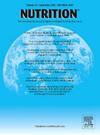The mediating role of perceived social isolation in feeding methods and depression among patients with dysphagia after ischemic stroke: A multicenter study
IF 3.2
3区 医学
Q2 NUTRITION & DIETETICS
引用次数: 0
Abstract
Background
Feeding methods may influence post stroke depression. Perceived social isolation may mediate this underlying mechanism. In this study we explored the effects of perceived social isolation on the relationship between feeding methods and post stroke depression.
Methods
This observational study was conducted between 2022 and 2024. The subjects were ischemic stroke survivors with dysphagia. Information was collected, including 1) depression levels (Patient Health Questionnaire-9 items [PHQ-9]), 2) demographic characteristics, 3) clinical conditions, 4) treatment details, and 5) perceived social isolation. After matching the baseline and treatment-related variables, a mediation model was used to analyze the relationship among perceived social isolation, feeding methods, and depression levels.
Results
There were 2764 participants (44.54% using Nasogastric Tube feeding [NGT]). Before matching, the PHQ-9 score for all participants on day 10 was significantly lower than that at admission (P < 0.001). After matching confounding factors, the PHQ-9 score on day 10 for the Intermittent Oro-Esophageal tube feeding (IOE) users was significantly lower than that of the NGT users [(7.03 ± 2.52) versus (9.25 ± 5.55), n1 = n2 = 800, P < 0.001]. The mediation model showed that 1) compared to NGT, IOE can cause significantly lower perceived social isolation on day 10 (effect = 5.808, P < 0.001); 2) compared to NGT, IOE can significantly lower depression levels on day 10 (effect = 0.180, P < 0.001); and (3) perceived social isolation showed partial mediating effects, and the proportion of the mediation effect was 47.19% (1.046/2.218, P < 0.001).
Conclusions
Compared to NGT, IOE can significantly improve post stroke depression levels. Perceived social isolation mediated the relationship between feeding methods and post stroke depression.
认知社会隔离在缺血性脑卒中后吞咽困难患者喂养方式和抑郁中的中介作用:一项多中心研究
喂养方式可能影响脑卒中后抑郁。感知到的社会孤立可能会调解这一潜在机制。在本研究中,我们探讨了感知社会孤立对喂养方式与脑卒中后抑郁之间关系的影响。方法观察性研究时间为2022 - 2024年。研究对象为伴有吞咽困难的缺血性中风幸存者。收集的信息包括:1)抑郁水平(患者健康问卷-9项[PHQ-9]), 2)人口统计学特征,3)临床情况,4)治疗细节,5)感知到的社会孤立。在匹配基线和治疗相关变量后,采用中介模型分析感知社会隔离、喂养方式和抑郁水平之间的关系。结果2764例患者(44.54%)采用鼻胃管喂养(NGT)。配对前,所有受试者第10天的PHQ-9得分均显著低于入院时(P <;0.001)。经混杂因素匹配后,间歇口食管管饲组(IOE)第10天PHQ-9评分显著低于NGT组(9.25±5.55),n1 = n2 = 800, P <;0.001]。中介模型显示:1)与NGT相比,IOE可以显著降低第10天的社会孤立感(effect = 5.808, P <;0.001);2)与NGT相比,IOE可以显著降低第10天的抑郁水平(效应= 0.180,P <;0.001);(3)感知社会隔离存在部分中介作用,中介作用比例为47.19% (1.046/2.218,P <;0.001)。结论与NGT相比,IOE能显著改善脑卒中后抑郁水平。认知社会孤立在喂养方式与脑卒中后抑郁之间起中介作用。
本文章由计算机程序翻译,如有差异,请以英文原文为准。
求助全文
约1分钟内获得全文
求助全文
来源期刊

Nutrition
医学-营养学
CiteScore
7.80
自引率
2.30%
发文量
300
审稿时长
60 days
期刊介绍:
Nutrition has an open access mirror journal Nutrition: X, sharing the same aims and scope, editorial team, submission system and rigorous peer review.
Founded by Michael M. Meguid in the early 1980''s, Nutrition presents advances in nutrition research and science, informs its readers on new and advancing technologies and data in clinical nutrition practice, encourages the application of outcomes research and meta-analyses to problems in patient-related nutrition; and seeks to help clarify and set the research, policy and practice agenda for nutrition science to enhance human well-being in the years ahead.
 求助内容:
求助内容: 应助结果提醒方式:
应助结果提醒方式:


